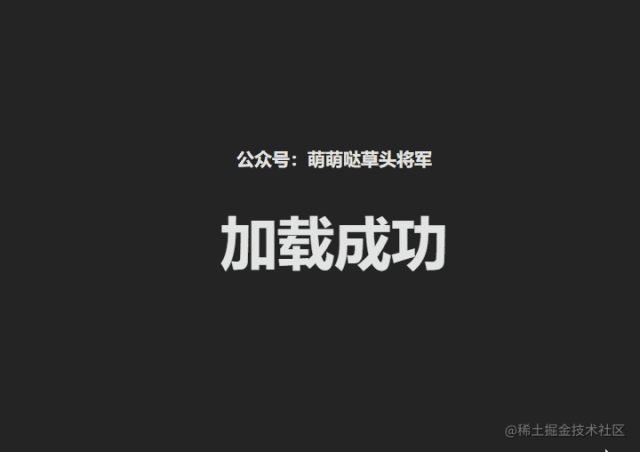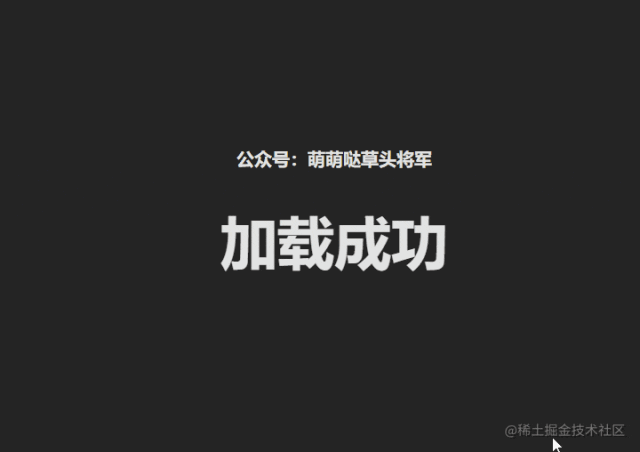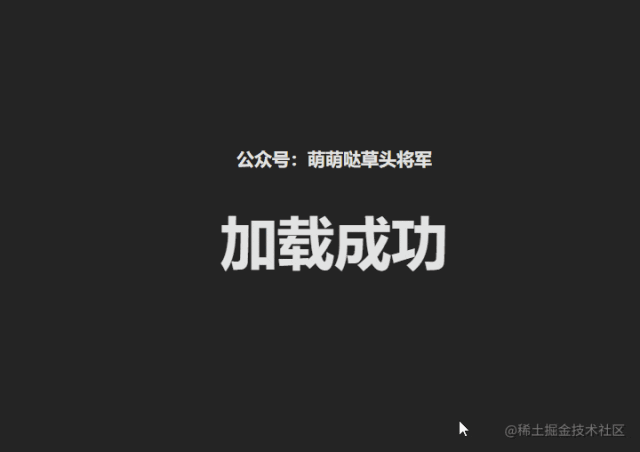🚀 关键接口介绍
最近想体验下自定义指令功能,看了看文档和 vue2 差异不大,语法如下:
const myDirective = {
// 在绑定元素的 attribute 前
// 或事件监听器应用前调用
created(el, binding, vnode, prevVnode)
{ // 下面会介绍各个参数的细节 },
// 在元素被插入到 DOM 前调用
beforeMount(el, binding, vnode, prevVnode) {},
// 在绑定元素的父组件
// 及他自己的所有子节点都挂载完成后调用
mounted(el, binding, vnode, prevVnode) {},
// 绑定元素的父组件更新前调用
beforeUpdate(el, binding, vnode, prevVnode) {},
// 在绑定元素的父组件
// 及他自己的所有子节点都更新后调用
updated(el, binding, vnode, prevVnode) {},
// 绑定元素的父组件卸载前调用
beforeUnmount(el, binding, vnode, prevVnode) {},
// 绑定元素的父组件卸载后调用
unmounted(el, binding, vnode, prevVnode) {}
}起初,最大的痛点是需要手动创建 dom ,然后插入 el 中。
const loadingDom = document.createElement('div', {calss: 'loading'})
el.append(loadingDom)这样好难受啊,我不想写原生 dom ,能不能写个组件渲染到指令里呢?
我想起了我之前看到的几个 vue 接口,
- h函数,也就是 vue 提供的创建 vNode 的函数
- render函数:将 vNode 渲染到 真实 dom 里的函数
h函数用法如下:
// 完整参数签名
function h(
type: string | Component,
props?: object | null,
children?: Children | Slot | Slots
): VNode例如:
import { h } from 'vue'
const vnode = h('div', { class: 'container' }, [
h('h1', 'Hello, Vue 3'),
h('p', 'This is a paragraph')
])我们使用h函数创建了一个 VNode,它表示一个包含 div、h1、p 的 DOM 结构。其中,div 的 class 属性为 container
🚀 自定义 loading 组件
然而,当我使用 props 为组件传递值时,发现是徒劳的。
import Loading from './components/Loading.vue';
cconst option = {
msg: '一大波僵尸来袭',
loading: true
}
const vnode = h(
Loading,
{ id: 'loading', ...option}
)仅仅如下图一样,我以为是给组件的 props,实际上是 dom 的 props。
 图片
图片
此时我们的组件只能通过 $attrs 来获取这些 props 了,如下:
<template>
<div class="loading">
<div></div>
<span v-if="$attrs.msg !== false">{{ $attrs.msg }}</span>
</div>
</template>接着我们给组件实现 loading 动画,当然你也可以直接使用组件库的 loading 组件。
我的实现如下:
<style>
@keyframes identifier {
100% {
-webkit-transform: rotate(360deg);
transform: rotate(360deg);
}
}
.loading {
height: 100px;
width: 100%;
}
.loading div {
width: 50px;
height: 50px;
border-radius: 50%;
border: 2px solid green;
margin: 25px auto;
border-top: none;
border-left: none;
animation: identifier 1s infinite linear;
}
</style>🚀 自定义指令
接下来我们封装自定义指令。
我们的思路是:
- mounted 阶段,如果是 true,那么渲染组件,否则什么都不做。
- update 阶段,如果 true 则重新渲染组件,如果 false 则渲染 vnode
为了可以应对更多场景,我们期望可以配置加载中的提示信息,不配置使用默认值,如果是 false ,那么仅展示 loading 图。所以参数类型如下:
interface Props {loading: boolean, msg?: string | false}
v-loading: boolean | Props由于可能是布尔值,也可能是对象,我们需要初始化配置参数
function formatOption (value: boolean | Props) {
const loading = typeof value === 'boolean'
? value
: value.loading
const option = typeof value !== 'boolean'
? Object.assign(defaultOption, value)
: {
loading,
...defaultOption
}
return { loading, option }
}接着再 mounted 阶段获取格式化后的 loading 和 option,如果为 true 则直接渲染组件。
const vLoading: Directive<HTMLElement, boolean | Props> = {
mounted(el, binding) {
const { loading, option } = formatOption(binding.value)
loading && renderLoading(el, option)
}
}
function renderLoading (el: HTMLElement, option: Props) {
const vnode = h(
Loading,
{ id: 'loading', ...option}
)
el.removeChild(el.children[0])
render(vnode, el)
}如果进入 update 阶段,则根据情况选择渲染 laoding 组件还是 vnode。
const vLoading: Directive<HTMLElement, boolean | Props> = {
mounted(el, binding) {
const { loading, option } = formatOption(binding.value)
loading && renderLoading(el, option)
},
updated(el: HTMLElement, binding, vnode) {
const { loading, option } = formatOption(binding.value)
if (loading) {
renderLoading(el, option)
} else {
renderVNode(el, vnode)
}
},
}
function renderLoading (el: HTMLElement, option: Props) {
const vnode = h(
Loading,
{ id: 'loading', ...option}
)
el.removeChild(el.children[0])
render(vnode, el)
}
function renderVNode (el: HTMLElement, vnode: VNode) {
el.querySelector('#loading')?.remove()
render(vnode, el)
}我们验证下功能:
- 默认功能
const loading = ref(true)
setTimeout(() => loading.value = false, 2000)
</script>
<template>
<div style="width: 300px" v-loading=laoding>
<h1>加载成功</h1>
</div>
</template> 图片
图片
- 自定义文本
<template>
<div style="width: 300px" v-loading="{ loading, msg: '一大波僵尸来袭' }">
<h1>加载成功</h1>
</div>
</template> 图片
图片
- 不展示文本
<template>
<div style="width: 300px" v-loading="{ loading, msg: false }">
<h1>加载成功</h1>
</div>
</template> 图片
图片
🎉 最后
今天的分享就到这了,如果有问题,可以评论区告诉我,我会及时更正。
以下是完整的代码。
<template>
<div class="loading">
<div></div>
<span v-if="$attrs.msg !== false">{{ $attrs.msg }}</span>
</div>
</template>
<script lang="ts">
export default {
}
</script>
<style>
@keyframes identifier {
100% {
-webkit-transform: rotate(360deg);
transform: rotate(360deg);
}
}
.loading {
height: 100px;
width: 100%;
}
.loading div {
width: 50px;
height: 50px;
border-radius: 50%;
border: 2px solid green;
margin: 25px auto;
border-top: none;
border-left: none;
animation: identifier 1s infinite linear;
}
</style><script setup lang="ts">
import { Directive, VNode, h, ref, render } from 'vue';
import Loading from './components/Loading.vue';
const defaultOption: {msg?: string | false} = {
msg: '努力加载中'
}
interface Props {loading: boolean, msg?: string | false}
function formatOption (value: boolean | Props) {
const loading = typeof value === 'boolean'
? value
: value.loading
const option = typeof value !== 'boolean'
? Object.assign(defaultOption, value)
: {
loading,
...defaultOption
}
return { loading, option }
}
function renderLoading (el: HTMLElement, option: Props) {
const vnode = h(
Loading,
{ id: 'loading', ...option}
)
el.removeChild(el.children[0])
render(vnode, el)
}
function renderVNode (el: HTMLElement, vnode: VNode) {
el.querySelector('#loading')?.remove()
render(vnode, el)
}
const vLoading: Directive<HTMLElement, boolean | Props> = {
mounted(el, binding) {
const { loading, option } = formatOption(binding.value)
loading && renderLoading(el, option)
},
updated(el: HTMLElement, binding, vnode) {
const { loading, option } = formatOption(binding.value)
if (loading) {
renderLoading(el, option)
} else {
renderVNode(el, vnode)
}
},
}
const loading = ref(true)
setTimeout(() => loading.value = false, 2000)
</script>
<template>
<div style="width: 300px" v-loading="{ loading, msg: '一大波僵尸来袭' }">
<h1>加载成功</h1>
</div>
</template>
































